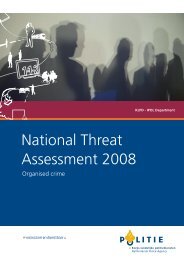Assessing the Effectiveness of Organized Crime Control Strategies ...
Assessing the Effectiveness of Organized Crime Control Strategies ...
Assessing the Effectiveness of Organized Crime Control Strategies ...
Create successful ePaper yourself
Turn your PDF publications into a flip-book with our unique Google optimized e-Paper software.
<strong>Assessing</strong> <strong>the</strong> <strong>Effectiveness</strong> <strong>of</strong> <strong>Organized</strong> <strong>Crime</strong> <strong>Control</strong> <strong>Strategies</strong>:<br />
A Review <strong>of</strong> <strong>the</strong> Literature<br />
While <strong>the</strong> measures <strong>of</strong> efficiency recommended by Blakey and his colleagues set more modest<br />
(and perhaps more realistic) objectives for evaluations, <strong>the</strong>y are plagued by all <strong>the</strong> abovementioned<br />
shortcomings <strong>of</strong> administrative body-counts. One would think that <strong>the</strong> ultimate<br />
objective is impact, ra<strong>the</strong>r than mere efficiency, however difficult <strong>the</strong> measure <strong>of</strong> impact may be.<br />
Harms Produced by <strong>Organized</strong> <strong>Crime</strong><br />
Maltz (1990) calls for harm-based measures <strong>of</strong> OC. Thus, assessments <strong>of</strong> OC control efforts<br />
should be based on <strong>the</strong> extent to which physical, economic, psychological, community, and<br />
societal harms, engendered by OC, have been mitigated. According to Maltz, evaluations might<br />
measure <strong>the</strong> volume <strong>of</strong> harm occurring in a jurisdiction on an annual basis. Before a reduction in<br />
<strong>the</strong> overall harm is attributed to a specific agency’s control efforts, <strong>the</strong> difficult task <strong>of</strong><br />
determining <strong>the</strong> contribution <strong>of</strong> o<strong>the</strong>r factors must be undertaken. O<strong>the</strong>r factors that may play a<br />
role in harm reduction include: <strong>the</strong> efforts <strong>of</strong> o<strong>the</strong>r agencies; natural changes in supply or<br />
demand (e.g., changing drug preferences, cocaine crop failure); non-enforcement phenomena<br />
(e.g., <strong>the</strong> death <strong>of</strong> a key OC figure); measurement error (e.g., less information available on a<br />
given activity than in <strong>the</strong> previous year); unknown sources; and random fluctuations (Maltz,<br />
1990:20).<br />
Measuring <strong>the</strong> harms produced by OC is more complex than in <strong>the</strong> case <strong>of</strong> conventional crimes<br />
such as robbery. Victims frequently report such conventional crimes to <strong>the</strong> police or mention<br />
<strong>the</strong>m in victimization surveys. By contrast, <strong>the</strong> recipients <strong>of</strong> <strong>the</strong> illicit goods and services<br />
furnished by criminal organizations act voluntarily and, hence, do not view <strong>the</strong>mselves as<br />
victims. Fur<strong>the</strong>rmore, <strong>the</strong> victims <strong>of</strong> non-consensual OC activities (e.g., extortion) <strong>of</strong>ten stay<br />
quiet due to intimidation.<br />
This harm-based approach is intuitively compelling as <strong>the</strong> ultimate goal <strong>of</strong> more broadly based<br />
OC control efforts is to minimize <strong>the</strong> adverse effects <strong>of</strong> criminal organizations. Whe<strong>the</strong>r <strong>the</strong> aim<br />
<strong>of</strong> a particular program is to “decapitate” a criminal organization or to reduce <strong>the</strong> supply <strong>of</strong> an<br />
illicit substance or service, achieving <strong>the</strong>se aims is <strong>of</strong> limited value if <strong>the</strong> harms produced by <strong>the</strong><br />
organization or substance are unabated. Measuring harms, however, is no simple task.<br />
The first category <strong>of</strong> harm defined by Maltz (1990) is physical harm. Even this, <strong>the</strong> most<br />
concrete <strong>of</strong> all harms, is difficult to measure with accuracy. The counting <strong>of</strong> acts <strong>of</strong> violence is<br />
impeded by a substantial “dark figure”. Even homicide, purportedly <strong>the</strong> most accurate barometer<br />
<strong>of</strong> violence, is counted with a significant degree <strong>of</strong> error (Gabor, Hung, Mihorean, and St. Onge,<br />
2002). Questions arise as to whe<strong>the</strong>r a violent death was due to an attack, was self-inflicted<br />
deliberately, or was unintentional. Also, <strong>the</strong> assessment <strong>of</strong> whe<strong>the</strong>r a homicide was a “gangland<br />
slaying” is not always clear.<br />
Measuring economic harms incurred by victims is also complex. The direct damage done to a<br />
commercial building that has been burned down can be quantified quite readily. Calculating <strong>the</strong><br />
secondary effects--<strong>the</strong> loss <strong>of</strong> a business, need for added security, higher insurance premiums,<br />
loss <strong>of</strong> wages, and o<strong>the</strong>r, more enduring effects—is a more difficult undertaking. Also, <strong>the</strong><br />
victim in this case would include <strong>the</strong> owners and occupants <strong>of</strong> <strong>the</strong> building, employees, as well<br />
16 | Research and Statistics Division / Department <strong>of</strong> Justice Canada








